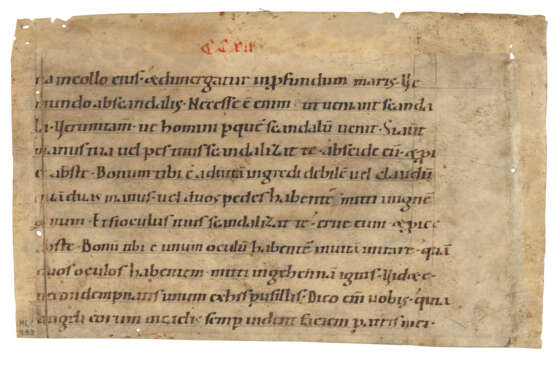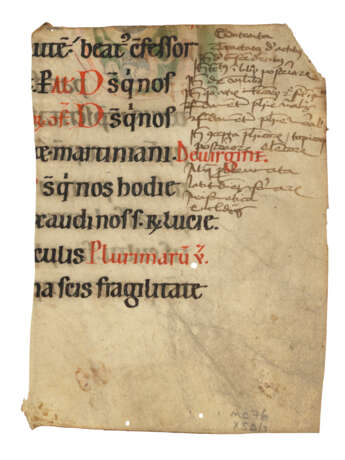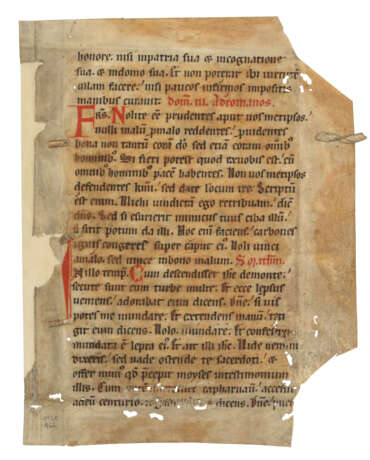ID 869552
Lot 145 | Early German leaves
Valeur estimée
£ 5 000 – 8 000
GERMANY: a study collection of leaves and fragments, in Latin, manuscripts on vellum [Germany, 12th to 13th centuries]
A selection of German liturgical and patristic leaves and fragments from the early 12th and 13th centuries.
Comprising:
(i) A fragment from a liturgical manuscript [?Germany, 12th century].
c.130 × 210mm. Preserving 11 lines, blind-ruled with pricking on fore-edge, written in late Caroline minuscule with rubrics in orange ink; with the foliation "CCXII", and text comprising part of Gregory the Great's Speculum vel liber de divinis scripturis, followed by collects for St Michael and St Jerome.
Provenance: Colker MS 233; acquired in 1974 from Maggs.
(ii) A fragment from a Missal [Germany, 12th century].
c.143 × 102mm. A lower corner fragment, preserving 8 lines, blind-ruled, in a late, very fine Caroline minuscule with lateral compression of letterforms and short ascenders and descenders, with part of a large pen-work decorative initial (?'D'), with twining vines.
Provenance: (1) Contents-list of scholastic and scientific works, 14th century; (2) Colker MS 394; acquired in 1987-88 from Quaritch.
(iii) Two fragments from a Lectionary [Germany, 12th century].
A fragment measuring c.60 × 125mm, the second c.68 × 54mm. Each preserving part of 8 lines, written in a late Caroline minuscule, with glosses in a contemporary hand (text faded, with small holes in vellum throughout).
Provenance: Colker MS 428; acquired in 1990 from Renzo Rizzi.
(iv) A partial bifolium from a Liturgical text [Germany, 12th century].
c.130 × 330mm. Preserving 14 lines, written in late Caroline minuscule, with liturgy for use during the Easter period (with a small tear in vellum).
Provenance: Colker MS 501; acquired in 2002 from Quaritch.
(v) A fragment from a work of Biblical Exegesis [Germany, 12th century].
c.38mm × 98mm. A small strip from a column, preserving 5 lines, written in a protogothic bookhand; from an unknown text relating the age of the first-born son of Noah to the birth of Abraham (creased and dirtied from use in a binding).
Provenance: (1) Stephan Beissel (1841-1915); (2) Colker MS 425; acquired in 1990 from Renzo Rizzi.
(vi) A leaf from Gregorius Magnus, Registrum Epistolarum [Germany, 12th century].
c.315 × 203mm. 37 lines, blind-ruled with pricking on the fore-edge, written in a fine protogothic bookhand, with marginal glosses in a contemporary hand; text comprising part of Gregory the Great's Registrum Epistolarum, Book 1, Letter 25 (dark staining behind text on both sides of the leaf, cockled).
Provenance: (1) Same as MS 332; (2) Colker MS 390; acquired in 1987-88 from Quaritch.
(vii) Two fragments of a Lectionary [Germany, 12th century].
Both fragments measure c.155 × 97mm. Each preserving 28 lines in a small protogothic script, rubrics in orange ink (remains of adhesive).
Provenance: (1) Apel Collection, Schloss Ermlitz, near Merseburg; (2) Colker MS 502; acquired in 2002 from Quaritch.
(viii) A leaf from Hildebert of Le Mans, Sermones [Germany, middle or third quarter 12th century].
c.261 × 184mm. 26 lines, pricking on fore-edge, written in a protogothic bookhand, verso with a modern drawing of an Ottonian ?Evangelist, copied from St Augustine, Sermons, published in Jacques Rosenthal, Catalogue 27: Manuscrits à miniatures et livres illustrés = Illuminated Manuscripts and Illustrated Books = Bilderhandschriften und illustrirte Bücher (Munich [June 1901]), no 7 (on this see the blogspot by P. Kidd for 6 November 2022, mssprovenance.blogspot.com), the text comprising part of Hildebert of Le Mans's Sermo XI (remains of adhesive).
Provenance: Colker MS 375; acquired in 1987–88 from Maggs.
(ix) Two bifolia from a Breviary with neums [?Germany, 12/13th century].
c.198 × 258mm. 23 lines, written in a rounded protogothic script (text lacking due to cropping on the left side of bifolia, small wormholes).
Provenance: Colker MS 393; acquired in 1987-1988 from Quaritch.
(x) A leaf from a Lectionary [Germany, c. 1200].
c.245 × 198mm. 25 lines, ruled in plummet, written in a late protogothic bookhand; with readings from the Letters to the Romans and Timothy, and from the Book of Matthew (vellum tags remain in gutter and outer margin, from use in a binding).
Provenance: Colker MS 466; acquired in 1996 from Maggs.
| Lieu d'origine: | Allemagne |
|---|---|
| Catégorie maison de vente aux enchères: | Manuscrits médiévaux et de la Renaissance |
| Lieu d'origine: | Allemagne |
|---|---|
| Catégorie maison de vente aux enchères: | Manuscrits médiévaux et de la Renaissance |
| Adresse de l'enchère |
CHRISTIE'S 8 King Street, St. James's SW1Y 6QT London Royaume-Uni | |
|---|---|---|
| Aperçu |
| |
| Téléphone | +44 (0)20 7839 9060 | |
| Commission | see on Website | |
| Conditions d'utilisation | Conditions d'utilisation |




























